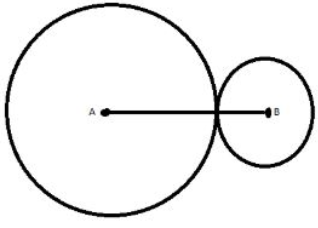
In the given figure, two circles touch externally. The sum of their areas is \[117\pi \,\,c{{m}^{2}}\] and the distance between their centers is 15 cm. Find the radii of the two circles.


Answer
591.9k+ views
Hint: Use the area of the circle formula, which is \[Area=\pi {{r}^{2}}\]. Now, the sum of total area of circles is equal to the \[117\pi \,\,c{{m}^{2}}\] thus we get a quadratic equation in either \[{{r}_{1}}\] or \[{{r}_{2}}\].
Complete step-by-step solution -
In the question, we have to find the radii of the two circles. So let the circle with center A has radius \[{{r}_{1}}\]and the second circle has the radius\[{{r}_{2}}\]. Now it is given that the two circles touch externally and the distance between their centers is 15 cm. So, the sum of the radius will give the distance between the centers of the circle.
\[\Rightarrow {{r}_{1}}+{{r}_{2}}=15 ……………. (eq\,\,1)\]
Next, it is given that sum of their areas is \[117\pi \,\,c{{m}^{2}}\]. Now the area of the two circles are \[{{A}_{1}}=\pi {{\left( {{r}_{1}} \right)}^{2}}\] and \[{{A}_{2}}=\pi {{\left( {{r}_{2}} \right)}^{2}}\]. So the equation that we will get will be:
\[\begin{align}
& \Rightarrow {{A}_{1}}+{{A}_{2}}=117\pi \\
& \Rightarrow \pi {{\left( {{r}_{1}} \right)}^{2}}+\pi {{\left( {{r}_{2}} \right)}^{2}}=117\pi \\
& \Rightarrow \pi \left[ {{\left( {{r}_{1}} \right)}^{2}}+{{\left( {{r}_{2}} \right)}^{2}} \right]=117\pi \\
& \Rightarrow \left[ {{\left( {{r}_{1}} \right)}^{2}}+{{\left( {{r}_{2}} \right)}^{2}} \right]=117 ………………………………..(eq2) \\
\end{align}\]
Now, we just need to solve the above two equations to get the value of the radii \[{{r}_{1}}\]and\[{{r}_{2}}\].
So we have:
\[\begin{matrix}
\Rightarrow {{r}_{1}}+{{r}_{2}}=15 …………………………..(1) \\
\Rightarrow {{\left( \;{{r}_{1}} \right)}^{2}}+{{\left( {{r}_{2}} \right)}^{2}}=117 ……………...(2) \\
\end{matrix}\]
Now, plugging \[{{r}_{1}}=15-{{r}_{2}}\]in equation (2), we get:
\[\begin{align}
& \Rightarrow {{\left( 15-{{r}_{2}} \right)}^{2}}+r_{2}^{2}=117 \\
& \Rightarrow 225-30{{r}_{2}}+r_{2}^{2}+r_{2}^{2}=117\, \\
& \Rightarrow 2r_{2}^{2}-30{{r}_{2}}+108=0 \\
\end{align}\]
Next, this is the quadratic equation of the form \[a{{x}^{2}}+bx+c=0\], where x will be given by the formula \[x=\dfrac{-b\pm \sqrt{{{b}^{2}}-4ac}}{2a}\].
Now, in this equation \[2r_{2}^{2}-30{{r}_{2}}+108=0\] we have \[a=2,b=-30,c=108\]. So the value of \[{{r}_{2}}\] will be as follows:
\[\begin{align}
& \Rightarrow {{r}_{2}}=\dfrac{-\left( -30 \right)\pm \sqrt{{{\left( -30 \right)}^{2}}-4\cdot \;2\cdot \;108}}{2\cdot \;2} \\
& \Rightarrow {{r}_{2}}=\dfrac{30\pm \sqrt{36}}{4} \\
& \Rightarrow {{r}_{2}}=9,{{r}_{2}}=6 \\
\end{align}\]
Now, using the equation\[{{r}_{1}}+{{r}_{2}}=15\,\,\,\], we will find the second radius as follows:
\[\begin{align}
& \Rightarrow {{r}_{1}}+9=15 \\
& \Rightarrow {{r}_{1}}\text{=6} \\
& \text{or} \\
& \Rightarrow {{r}_{1}}+6=15 \\
& \Rightarrow {{r}_{1}}\text{=9} \\
\end{align}\]
So the values of two radii are: \[\left( \begin{matrix}
{{r}_{1}}=6,\; & {{r}_{2}}=9 \\
{{r}_{1}}=9,\; & {{r}_{2}}=6 \\
\end{matrix} \right)\]. This is the required answer.
Note: It is to be noted here that if two circles are touching externally, then the minimum distance between their centers will be the sum of the radii of two circles. for solving the quadratic equation we can use the factorization by splitting the middle term.
Complete step-by-step solution -
In the question, we have to find the radii of the two circles. So let the circle with center A has radius \[{{r}_{1}}\]and the second circle has the radius\[{{r}_{2}}\]. Now it is given that the two circles touch externally and the distance between their centers is 15 cm. So, the sum of the radius will give the distance between the centers of the circle.
\[\Rightarrow {{r}_{1}}+{{r}_{2}}=15 ……………. (eq\,\,1)\]
Next, it is given that sum of their areas is \[117\pi \,\,c{{m}^{2}}\]. Now the area of the two circles are \[{{A}_{1}}=\pi {{\left( {{r}_{1}} \right)}^{2}}\] and \[{{A}_{2}}=\pi {{\left( {{r}_{2}} \right)}^{2}}\]. So the equation that we will get will be:
\[\begin{align}
& \Rightarrow {{A}_{1}}+{{A}_{2}}=117\pi \\
& \Rightarrow \pi {{\left( {{r}_{1}} \right)}^{2}}+\pi {{\left( {{r}_{2}} \right)}^{2}}=117\pi \\
& \Rightarrow \pi \left[ {{\left( {{r}_{1}} \right)}^{2}}+{{\left( {{r}_{2}} \right)}^{2}} \right]=117\pi \\
& \Rightarrow \left[ {{\left( {{r}_{1}} \right)}^{2}}+{{\left( {{r}_{2}} \right)}^{2}} \right]=117 ………………………………..(eq2) \\
\end{align}\]
Now, we just need to solve the above two equations to get the value of the radii \[{{r}_{1}}\]and\[{{r}_{2}}\].
So we have:
\[\begin{matrix}
\Rightarrow {{r}_{1}}+{{r}_{2}}=15 …………………………..(1) \\
\Rightarrow {{\left( \;{{r}_{1}} \right)}^{2}}+{{\left( {{r}_{2}} \right)}^{2}}=117 ……………...(2) \\
\end{matrix}\]
Now, plugging \[{{r}_{1}}=15-{{r}_{2}}\]in equation (2), we get:
\[\begin{align}
& \Rightarrow {{\left( 15-{{r}_{2}} \right)}^{2}}+r_{2}^{2}=117 \\
& \Rightarrow 225-30{{r}_{2}}+r_{2}^{2}+r_{2}^{2}=117\, \\
& \Rightarrow 2r_{2}^{2}-30{{r}_{2}}+108=0 \\
\end{align}\]
Next, this is the quadratic equation of the form \[a{{x}^{2}}+bx+c=0\], where x will be given by the formula \[x=\dfrac{-b\pm \sqrt{{{b}^{2}}-4ac}}{2a}\].
Now, in this equation \[2r_{2}^{2}-30{{r}_{2}}+108=0\] we have \[a=2,b=-30,c=108\]. So the value of \[{{r}_{2}}\] will be as follows:
\[\begin{align}
& \Rightarrow {{r}_{2}}=\dfrac{-\left( -30 \right)\pm \sqrt{{{\left( -30 \right)}^{2}}-4\cdot \;2\cdot \;108}}{2\cdot \;2} \\
& \Rightarrow {{r}_{2}}=\dfrac{30\pm \sqrt{36}}{4} \\
& \Rightarrow {{r}_{2}}=9,{{r}_{2}}=6 \\
\end{align}\]
Now, using the equation\[{{r}_{1}}+{{r}_{2}}=15\,\,\,\], we will find the second radius as follows:
\[\begin{align}
& \Rightarrow {{r}_{1}}+9=15 \\
& \Rightarrow {{r}_{1}}\text{=6} \\
& \text{or} \\
& \Rightarrow {{r}_{1}}+6=15 \\
& \Rightarrow {{r}_{1}}\text{=9} \\
\end{align}\]
So the values of two radii are: \[\left( \begin{matrix}
{{r}_{1}}=6,\; & {{r}_{2}}=9 \\
{{r}_{1}}=9,\; & {{r}_{2}}=6 \\
\end{matrix} \right)\]. This is the required answer.
Note: It is to be noted here that if two circles are touching externally, then the minimum distance between their centers will be the sum of the radii of two circles. for solving the quadratic equation we can use the factorization by splitting the middle term.
Recently Updated Pages
Two men on either side of the cliff 90m height observe class 10 maths CBSE

What happens to glucose which enters nephron along class 10 biology CBSE

Cutting of the Chinese melon means A The business and class 10 social science CBSE

Write a dialogue with at least ten utterances between class 10 english CBSE

Show an aquatic food chain using the following organisms class 10 biology CBSE

A circle is inscribed in an equilateral triangle and class 10 maths CBSE

Trending doubts
Why is there a time difference of about 5 hours between class 10 social science CBSE

Write a letter to the principal requesting him to grant class 10 english CBSE

What is the median of the first 10 natural numbers class 10 maths CBSE

The Equation xxx + 2 is Satisfied when x is Equal to Class 10 Maths

Which of the following does not have a fundamental class 10 physics CBSE

State and prove converse of BPT Basic Proportionality class 10 maths CBSE




